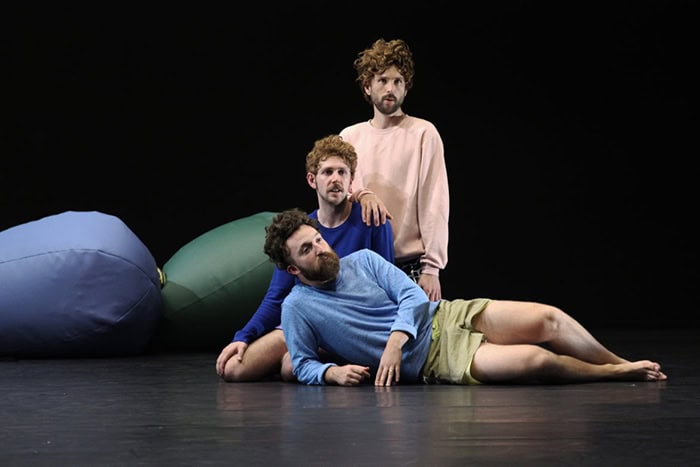Double bill of HARLEKING and The Passion of Andrea 2 at The Place
Posted: April 30th, 2020 | Author: Nicholas Minns & Caterina Albano | Filed under: Performance | Tags: Alberto Ruiz Soler, Annegret Schalke, Demetrio Castellucci, Enrico Ticconi, Ginevra Panzetti, Lewys Holt, Luke Divall, Lydia Sonderegger, Mathis Kleinschnittger, Simone Mousset | Comments Off on Double bill of HARLEKING and The Passion of Andrea 2 at The PlaceDouble Bill: HARLEKING, and The Passion of Andrea 2, The Place, February 26

Both works on this program weave the power of laughter into contemporary forms of tragedy. In HARLEKING, Ginevra Panzetti and Enrico Ticconi use silent laughter as a mimetic trait related to, but abstracted from, Italian Commedia dell’Arte; laughter is the physiological subject the two performers employ in a form disengaged from its underlying affect. With eloquence, intensity and riveting mimicry they present their manipulation of gesture knowingly, from states of innocence to underhanded treachery. The work does not set out to achieve historical context; as Panzetti and Ticconi explain, ‘it is reminiscent of the Grotesques, ancient wall decorations, in which monstrous figures emerge and blend in with elegant ornamental volutes’. It is this duality of monstrosity and elegance that suffuses their performance; in their black costumes against a white floor and backdrop under Annegret Schalke’s lighting, Panzetti and Ticconi accentuate gesture, creating the impression of two metamorphosed gargoyles on a night out from their cathedral perch, displaying a detached emotional behaviour derived from centuries of inanimate observation. Demetrio Castellucci’s sound interpolation further wraps the visual imagery in readings that alternate between teasing playfulness and psychotic malevolence.
Constantly playing on the idiom of ‘falling about laughing’ or ‘dying of laughter’, Panzetti and Ticconi adjust the semiotic relationship of laughter to danger by subtle variations. In a central section of hypnotic gestural play, the appearance of a fascist salute appears as little more than a beguiling sign among others, while towards the end of the work, the transformation of a loving embrace into a murderous grip loses the emotional intent between the signifier and what is signified; in each case it is left to the audience to feel the chilling effect.
While HARLEKING is a spectacle in the traditional proscenium perspective, Simone Mousset’s The Passion of Andrea 2 defies any traditional mould. Mousset has suggested the work describes an inability to grasp the confusion of current events and the consequent suspension of belief in personal agency. Negative space is difficult to frame, and the first impression of The Passion of Andrea 2 is that it has no point of reference; its action is set in a timeless present that has no past (despite the indication of a sequel) and no future. Lydia Sonderegger’s large inflatable sculptures suspended above the stage lend credence to an imaginary dreamscape in which arbitrariness weighs heavily. The first indication of human agency is the improbable appearance of three hapless characters, costumed and bewigged in triplicate, wandering aimlessly as if afflicted with debilitating fatigue. It is immediately apparent from their gestures and mimicry, however, that the absurdist tragedy is being undermined by consummate humour. When they greet each other with an auspicious display of energy we learn they are each named Andrea and their past is now revealed in a favourite trio they attempt to remember.
Mousset aligns the role of her three Andreas — Lewys Holt, Luke Divall and Mathis Kleinschnittger — with the Shakespearean jester whose artful clowning camouflages a disturbing reality. In their state of constant fluidity, the only anchor the Andreas have is their relationship to the audience, but even here its nature is ambiguous. They dissolve us in laughter with their absurdities and by involving us in their deadly competitive games, but there is a sense that Mousset is using them to hold up a mirror, that the work exists only in its ability to draw us into a state of reflection she wants us to share. Perhaps in our era of blatant political opportunism and misinformation absurdity is not so much a subversive antidote to the dis-ease of individual helplessness but a way of understanding it.
From its initial manifestation in 2018 at Touch Wood, the enlargement of The Passion of Andrea 2 with a substantial musical element and Sonderegger’s set, costumes and wigs, has lost nothing of its original affect. In mixing theatrical genres, Mousset has enhanced the absurdity at the work’s core with a tonic of choreographic, musical and textual play that is disarmingly funny in inverse proportion to the darkness of its inspiration.
Towards the end, following the Shakespearean demise of all three Andreas, Mousset introduces an epilogue in which sound designer Alberto Ruiz Soler is spirited on to the stage to explain, through a commentary by the resurrected Holt, that what we have just seen is in fact The Passion of Andrea 1 and that its sequel is about to begin. Soler dies, and the united Andreas climb into the audience singing a medieval round.